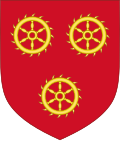This article needs additional citations for verification .(April 2025) |
| Duchess of Richmond | |
|---|---|
Incumbent since 1 September 2017Janet Gordon-Lennox | |
| Style | Her Grace |
| Member of | Gordon-Lennox family |
| Term length | As long as married to the Duke of Richmond |
| Formation |
|
| First holder | Mary Fitzroy |
The Duchess of Richmond is the wife of the Duke of Richmond, an extant title in the Peerage of England that has been created four times, originally in 1525.
Contents
- Countesses
- Countesses of Richmond (1218–1235)
- Countesses of Richmond (1341–1342)
- Countesses of Richmond (1342–1372)
- Countesses of Richmond (1372–1425)
- Countesses of Richmond (1414–1435)
- Countesses of Richmond (1452–1509)
- Duchesses
- Duchesses of Richmond & Somerset (1525–1536)
- Duchesses of Richmond (1623–1624)
- Duchesses of Richmond (1641–1672)
- Duchesses of Richmond (1675–Present)
- References

















